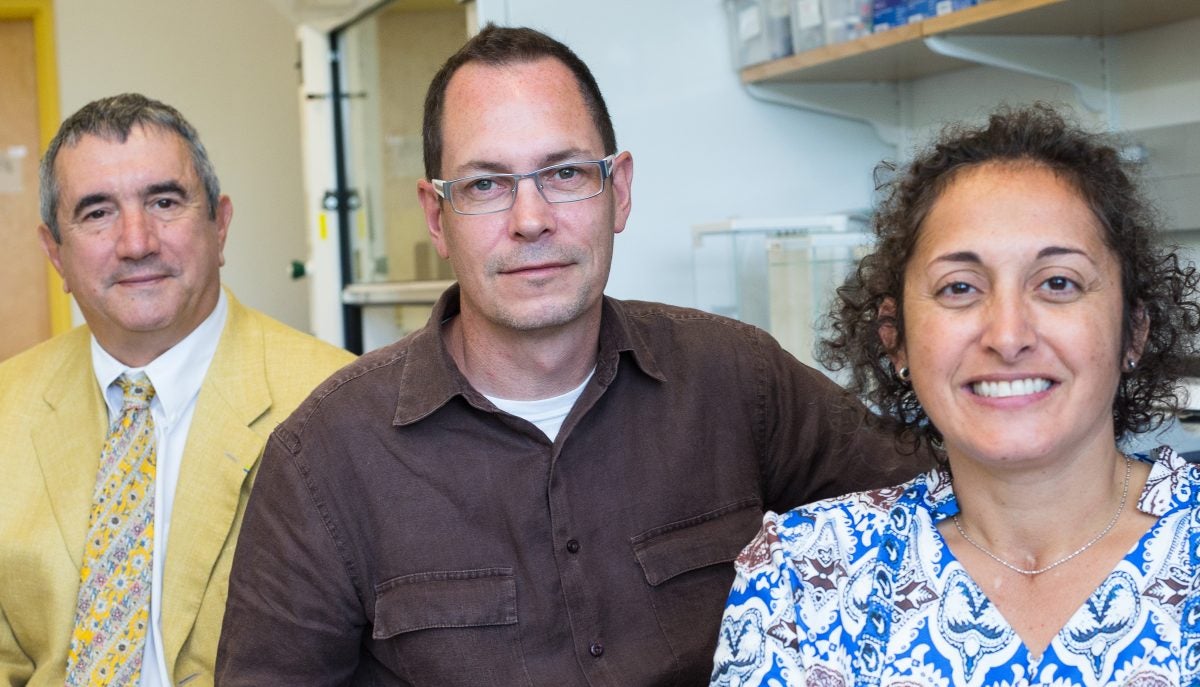Research team works to prevent blood donation spoilage
Every two seconds someone in the United States needs blood and, despite nearly 6.8 million domestic blood donors each year, blood banks face a serious problem.
Blood has a very short shelf life of 42 days, leading to up to 3% of all eligible blood donations to the Red Cross being discarded each year, according to the organization.

A trio of East Carolina University researchers has discovered a novel way to improve the storage and preservation of blood. Jean-Luc Scemama, from left, Anthony Kennedy and Jitka Virag are using a sweetener most commonly found in Splenda to keep blood fresher for longer. (Photo by Cliff Hollis)
To solve this issue, a trio of East Carolina University researchers has discovered a novel way to improve the storage and preservation of blood. The interdisciplinary group includes Anthony Kennedy, associate professor of chemistry; Jitka Virag, associate professor of physiology; and Jean-Luc Scemama, associate professor of biology.
The team first made the discovery while investigating how different sugars could preserve cells at subzero temperatures. Traditionally, cells are stored using toxic cryopreservatives such as glycerol. For cryopreserved blood, the preservative must be removed before a patient can receive an infusion. The cleaning process is expensive, needs highly trained labor and can result in unusable blood.
The ECU team found that sucralose – an artificial sweetener most commonly found in Splenda – can serve as a replacement for toxic cryopreservatives. This substitute offers an inexpensive alternative that reduces ice crystal formation during deep freeze storage. Their early research suggests that this method could be used across a wide range of cell types, tissues and organs, providing benefits across the medical field, especially for those with rare blood types.
Virag, a co-inventor of the technology, said this new technique could help stem the loss of preserved blood.
“There is a lot of need for (new preservation techniques) and the problem is, you only have a (short) shelf life until you have to throw it out,” Virag said. “We have all these blood drives that are going on, but unless you can save the blood, it’s a huge loss.”
Moving forward, the research team began to experiment and observe what effect sucralose may have on frozen blood preservation. To their surprise, sucralose protected red blood cells from bursting when refrigerated. This new finding opened the door for the technology to be applied to extend the shelf life of red blood cells and give new life to blood donations that previously would have been thrown away.
Kennedy, Virag and Scemama have worked on their research and technology for several years. The team said that ECU’s Office of Innovation and New Ventures has been an extremely valuable resource throughout their research. The team was awarded a patent in 2016 (US20170079261A1) for freezing red blood cells, and additional patent protection is being pursued regarding cell preservation at refrigerated temperatures using sucralose.
Each inventor works in a different department at ECU. The group said that the benefit of working with an interdisciplinary team is having the ability to see how different people think, work and approach issues.
“I think it’s important for the people involved in the project to respect each other,” Scemama said. “It makes a huge difference to work with people you feel comfortable with and who accept your differences.”
According to the team, one of the reasons they continue to push the project is that they are able to make their time together enjoyable. Kennedy said many times they meet off campus outside of business hours, often at a restaurant where they can discuss business, grab a meal and have a good laugh.
“We have a lot of fun together, intellectually and socially,” Virag said.
Kennedy hopes to partner with individuals that are interested in commercializing the team’s discovery and looks forward to translating the technology into other model systems including organ transplantation.
Learn more about the research team through the Office of Innovation and New Ventures.
-by Maggie Riddle, Innovation and New Ventures Intern